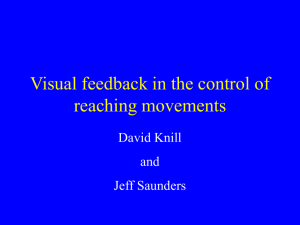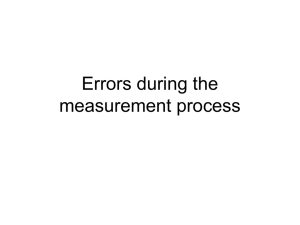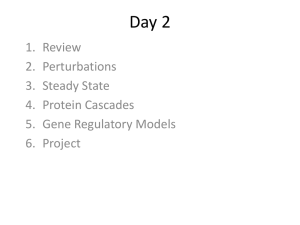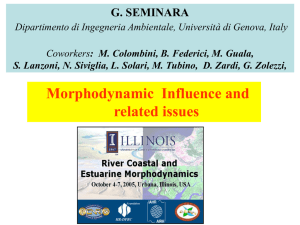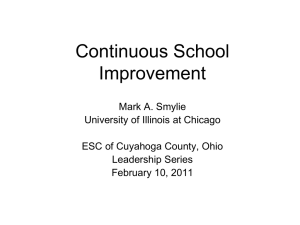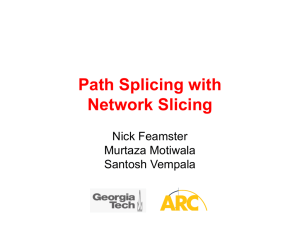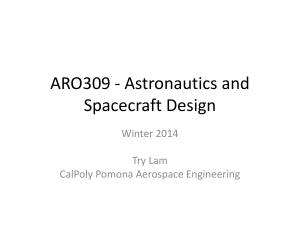PPT - CCAR - University of Colorado Boulder
advertisement
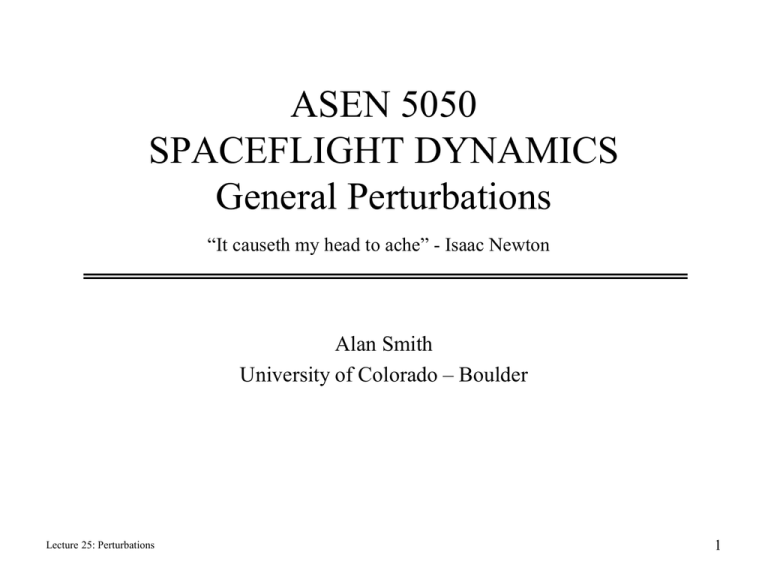
ASEN 5050 SPACEFLIGHT DYNAMICS General Perturbations “It causeth my head to ache” - Isaac Newton Alan Smith University of Colorado – Boulder Lecture 25: Perturbations 1 Announcements • Homework #7 is out now! Due Monday morning. – Clarification for Problem 3: you do not have to implement BOTH a variable time-step integrator and a fixed time-step integrator. Pick one. Then fill in that half of the table. • Reading: Chapters 8 and 9 Lecture 24: General Perturbations 2 Schedule from here out • • • 10/27: Three-Body Orbits 10/29: General Perturbations (Alan) 10/31: General Perturbations part 2 • • • 11/3: Mission Orbits / Designing with perturbations 11/5: Interplanetary 1 11/7: Interplanetary 2 • • • 11/10: Entry, Descent, and Landing 11/12: Low-Energy Mission Design 11/14: STK Lab 3 • • • 11/17: Low-Thrust Mission Design (Jon Herman) 11/19: Finite Burn Design 11/21: STK Lab 4 • Fall Break • • • 12/1: Constellation Design, GPS 12/3: Spacecraft Navigation 12/5: TBD • 12/8: TBD • 12/10: TBD Lecture 24: General Perturbations • 12/12: Final Review 3 Schedule from here out • Our last lecture will be Friday 12/12. – – • Final review and final Q&A. Showcase your final projects – at least any that are finished! Final Exam – – Handed out on 12/12 Due Dec 18 at 1:00 pm – either into D2L’s DropBox or under my door. • I heartily encourage you to complete your final project website by Dec 12th so you can focus on your finals. However, if you need more time you can have until Dec 18th. As such the official due date is Dec 18th. • The final due date for everything in the class is Dec 18th - no exceptions unless you have a very real reason (medical or otherwise - see CU's policies here: http://www.colorado.edu/engineering/academics/policies/grading). Of course we will accommodate real reasons. • If you are a CAETE student, please let me know if you expect an issue with this timeframe. We normally give CAETE students an additional week to complete everything, but the grades are due shortly after the 18th for everyone. So please see if you can meet these due dates. Lecture 19: Perturbations 4 Final Project • Get started on it! • Worth 20% of your grade, equivalent to 6-7 homework assignments. • Find an interesting problem and investigate it – anything related to spaceflight mechanics (maybe even loosely, but check with me). • Requirements: Introduction, Background, Description of investigation, Methods, Results and Conclusions, References. • You will be graded on quality of work, scope of the investigation, and quality of the presentation. The project will be built as a webpage, so take advantage of web design as much as you can and/or are interested and/or will help the presentation. Lecture 24: General Perturbations 5 Final Project • Instructions for delivery of the final project: • Build your webpage with every required file inside of a directory. – – – • Name your main web page “index.html” – • Name the directory “<LastName_FirstName>” there are a lot of duplicate last names in this class! You can link to external sites as needed. i.e., the one that you want everyone to look at first Make every link in the website a relative link, relative to the directory structure within your named directory. – We will move this directory around, and the links have to work! • Test your webpage! Change the location of the page on your computer and make sure it still works! • Zip everything up into a single file and upload that to the D2L dropbox. Lecture 24: General Perturbations 6 Space News • Rockets are tricky. • Sad day for Orbital and its customers yesterday. Hopefully we will pick up all the pieces and come out of it even stronger. – No injuries reported, thankfully. And the ISS is not low on any critical supplies. Lecture 25: Perturbations 7 ASEN 5050 SPACEFLIGHT DYNAMICS General Perturbations “It causeth my head to ache” - Isaac Newton Alan Smith University of Colorado – Boulder Lecture 25: Perturbations 8 Perturbations Special Perturbation Techniques – Numerical integration. Straightforward – however obtaining a good understanding of the effects on the orbit is difficult. General Perturbations – Use approximations to obtain analytical descriptions of the effects of the perturbations on the orbit. Assumes perturbing forces are small Early work used general perturbations because of a lack of computational power. Modern work uses special perturbations (numerical integration) because of the wide availability of computers. GP still useful for increasing your understanding. Still used by AF for maintaining space object catalog (> 7000 objects). Lecture 25: Perturbations 9 Trend Analyses • While it’s useful to be able to numerically integrate high-fidelity equations of motion, it’s also useful to have an expectation of possible effects for mission design and analysis • Drag – Clear reduction in a and e; can also impact i and the others slightly. • SRP – Depends, but in some circumstances it can increase e • Earth’s oblateness – Dramatic change in Ω, ω, and M • Third-body effects – Precession of the nodes, same effect as oblateness. Lecture 25: Perturbations 10 Trend Analyses • Secular Trends • Long periodic effects • Short periodic effects • Mean elements • Osculating elements Lecture 25: Perturbations 11 General Perturbation Techniques Perturbations can be categorized as secular, short period, long period. Lecture 25: Perturbations 12 Method of Perturbations • What is a small parameter? – – – – – J2 Cl,m, Sl,m a / a3 Thrust / acc2B Etc • We need a way to generate the approximation. We’ll use the method of Variation of Parameters (VOP) Lecture 25: Perturbations 13 Variation of Parameters • VOP was developed by Euler and improved by Lagrange (1873) • Describes the variations in the orbital elements over time to first order constants. • Need: – Unperturbed system as a reference (2-body solution). – A way to generalize the constants in the system to be timevarying parameters. Lecture 25: Perturbations 14 Variation of Parameters • Consider a system of six first-order differential equations: • These c parameters are osculating elements since they’re no longer constant. Lecture 25: Perturbations 15 Variation of Parameters • Any six elements may be used, including the conventional Keplerian orbital elements. But this isn’t necessary. • These parameters are a solution to: – If no perturbation, then we’d have conic sections. Lecture 25: Perturbations 16 Variation of Parameters • Any six elements may be used, including the conventional Keplerian orbital elements. But this isn’t necessary. • These parameters are a solution to: – In the presence of perturbations, what is this? Lecture 25: Perturbations 17 Variation of Parameters • Unperturbed and perturbed relationships for the velocity: • We impose a constraint: the condition of osculation Lecture 25: Perturbations 18 Variation of Parameters • If we take the derivative of the perturbed velocity using the condition of osculation, we obtain: Lecture 25: Perturbations 19 Variation of Parameters • We substitute this equation into our earlier: Lecture 25: Perturbations 20 Variation of Parameters • We have: • We can simplify this using our reference – that our unperturbed equations of motion hold for any given instant in time: Lecture 25: Perturbations 21 Variation of Parameters • We have: Lecture 25: Perturbations 22 Variation of Parameters • We have: • This is a system of three equations of six variables. We need three more equations! • Condition of osculation: Lecture 25: Perturbations 23 Variation of Parameters • Now we have 6 equations with 6 variables Lecture 25: Perturbations 24 Variation of Parameters • Now we have 6 equations with 6 variables • Not well-suited for computation. We need this to be of the form: Lecture 25: Perturbations 25 Variation of Parameters • Two well-known ways to convert to • Lagrangian VOP and Gaussian VOP – Gauss’ is easier to present first, though Vallado presents Lagrange’s first. We’ll do Gauss then Lagrange Lecture 25: Perturbations 26 Gaussian VOP • Start by taking the dot product of the first equation with and the dot product of the second with and add them together: Lecture 25: Perturbations 27 Gaussian VOP • The parameters are mutually independent, so the term inside of the parentheses simplifies to the Kronecker delta function (1 for i=j, 0 else) • Hence: Lecture 25: Perturbations Or... 28 Gaussian VOP • The hard part! • Gauss chose to perform these partial derivatives in the RSW coordinate frame. The disturbing force is thus: Lecture 25: Perturbations 29 Gaussian VOP ^ K Cross-track ^ W ^ W ^ N Figure 2. v ^ S Along-track ^ I ^ v, T, in-track ^ J ^ R Radial Satellite Coordinate Systems, RSW and NTW. These coordinate systems move with the satellite. The R axis points to the satellite, the W axis is normal to the orbital plane (and not usually aligned with the K axis), and the S axis is normal to the position vector and positive in the direction of the velocity vector. The S axis is aligned with the velocity vector only for circular orbits. In the NTW system, the T axis is always parallel to the velocity vector. The N axis is normal to the velocity vector and is not aligned with the radius vector, except for circular orbits, and at apogee and perigee in elliptical orbits. We define in-track or tangential displacements as deviations along the T axis. In-track30 errors are not the same as along-track variations in the RSW system. One way to remember the distinction is Lecture 25: Perturbations the RSW system). Gaussian VOP • Vallado provides page after page of derivations of these partials. The result: Lecture 25: Perturbations 31 Gaussian VOP Lecture 25: Perturbations 32 Gaussian VOP • Note a few limitations: • e must be < 1.0 • i and e can’t be 0 • Hence, this is limited to moderately elliptical, nonequatorial orbits. Lecture 25: Perturbations 33 Lagrangian VOP • Let’s restart and derive the Lagrange planetary equations of motion (LPEs), or simply the Lagrangian VOP • Lagrange was the first person to perform this transformation. Lecture 25: Perturbations 34 Lagrangian VOP • Take the dot product of the top vector with • And the dot product of the bottom vector with • Yields: Lecture 25: Perturbations 35 Comparison • Gauss: • Lagrange: Disturbing potential in 6 parameters Lecture 25: Perturbations 36 Lagrangian VOP • We have: • Lagrange brackets: Lecture 25: Perturbations 37 Lagrangian VOP • We have: Lecture 25: Perturbations 38 Lagrangian VOP • Some characteristics of Lagrange brackets: Lecture 25: Perturbations 39 Lagrangian VOP • Thus many of the values are easy. The remainder are tricky. – Diagonal terms = 0 – L = Skew-symmetric • Since the brackets are independent of time, we can evaluate them anywhere along the orbit. – Convenient to evaluate them at periapse! – Convert state to PQW (perifocal) frame. Lecture 25: Perturbations 40 Lagrangian VOP • Convert to PQW: Lecture 25: Perturbations 41 Lagrangian VOP • Convert to PQW: Note! Lecture 25: Perturbations 42 Lagrangian VOP • Convert to PQW: Lecture 25: Perturbations 43 Lagrangian VOP • Convenient independence: Lecture 25: Perturbations 44 Lagrangian VOP • We can also determine the PQW position and velocity vectors at periapse: Lecture 25: Perturbations 45 Lagrangian VOP • Three cases arise: Lecture 25: Perturbations 46 Lagrangian VOP • After a lot of math: Lecture 25: Perturbations 47 Lagrangian VOP • Note a few limitations: • e must be < 1.0 • i and e can’t be 0 • Hence, this is limited to moderately elliptical, nonequatorial orbits. • That seemed a LOT like the Gaussian VOP result Lecture 25: Perturbations 48 VOPs • Lagrangian Perturbing Potential Function Lecture 25: Perturbations Gaussian Forcing function in RSW 49 Lagrangian VOP • Constructing perturbing potential functions • Consider the spherical harmonic gravitational potential. – Take that potential function, remove the 2-body term, and re-cast it in terms of the classical orbital elements. – This leads to Kaula’s Solution: – Can then evaluate it in the Lagrange planetary equations. Lecture 25: Perturbations 50 L.P.E.s & Kaula’s Solution Lecture 25: Perturbations 51 Using the L.P.E.s • Let’s use the Lagrange planetary equations (LPEs) to evaluate the secular trends caused by a 2x2 gravity field. • Start with the potential function, R: Lecture 25: Perturbations 52 Using the L.P.E.s • Remove all periodic effects • Left with: Lecture 25: Perturbations 53 Using the L.P.E.s • Convert to orbital elements: • We convert latitude: • And use trig: Lecture 25: Perturbations 54 Using the L.P.E.s • Remove periodic terms again: • Yielding: Lecture 25: Perturbations 55 Using the L.P.E.s • The value of a/r varies over an orbit, since r varies. • Average it over an orbit. Lecture 25: Perturbations 56 Using the L.P.E.s • Evaluate this potential in the LPEs: • Consider RAAN Lecture 25: Perturbations 57 Using the L.P.E.s • After simplifying, we find: 1st-order secular trend of RAAN over time as a function of the orbit! Lecture 25: Perturbations 58 Using the L.P.E.s • We can certainly make this trend more accurate by considering the first six zonals (S.H. order = 0): Lecture 25: Perturbations 59 Using the L.P.E.s • Similar techniques reveal other secular trends. Lecture 25: Perturbations 60 Oblateness Perturbations h df df Lecture 25: Perturbations mr r˙˙ = - 3 + df r mr ˙ ˙ r ´ r = -r ´ 3 + r ´ df r d (r ´ r˙ ) = h˙ = r ´ df dt 61 General Perturbation Techniques Which is a “secularly precessing ellipse”. The equatorial bulge introduces a force component toward the equator causing a regression of the node (for prograde orbits) and a rotation of periapse. Note: w˙ = 0 for i = 63.4° or 116.6° Lecture 25: Perturbations 62 General Perturbation Techniques Lecture 25: Perturbations 63 General Perturbation Techniques Lecture 25: Perturbations 64 General Perturbation Techniques Periapse also precesses. w = 0 at the critical inclination, iw = 63.4 (116.6) Lecture 25: Perturbations 65 General Perturbation Techniques Lecture 25: Perturbations 66 General Perturbation Techniques Application: Sun Synchronous orbits 360° 365.2421897 = 0.985647 deg/day Can adjust a, e, i to accomodate this. h = 800 km, e = 0.0, i = 98.6° W SEC desired = Lecture 25: Perturbations 67 General Perturbation Techniques Sun Synchronous orbits: – Orbit plane remains at a constant angle (W’) with respect to the Earth-Sun line. – Orbit plane precession about the Earth is equal to period of Earth’s orbit about the Sun. Lecture 25: Perturbations 68 Perturbation Magnitudes ISS Orbit Lecture 25: Perturbations 69 Perturbation Magnitudes GPS Orbit Lecture 25: Perturbations 70 FIN Lecture 25: Perturbations 71
